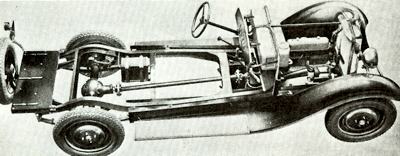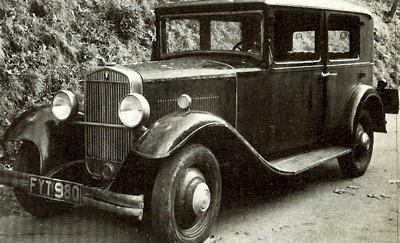|
Wanderer
|
1887
- 1939 |
Country: |
 |
|
Herrn Jaenicke and Winkelhofer
In 1887 Herrn Jaenicke and Winkelhofer began building bicycles in Chemnitz, in the German state of Saxony; in 1902 they added motor-cycles to their output, and during the next few years built the odd experimental light car, such as the Wandermobil of 1905. Around 1910 they decided that it was time that they started car production in earnest, and were approached by young car designer Ettore Bugatti, who was trying to sell the design of a neat little four-cylinder car with an ingenious two-speed transmission which used concentric propeller shafts and dual crown wheel and pinion sets of different sizes: but Wanderer were not interested, and so Bugatti sold the design to Peugeot, who produced it as the immortal Bebe.
The Wanderer 'Puppchen'
Wanderer's first car, the 'Puppchen' (doll) was a curious little vehicle, which had tandem seating like the crudest of cyclecars, yet was built of high-grade materials, and was thus rather costly to buy. It had a 1150cc four-cylinder ohv engine, which gave quite a lively performance, but the long, narrow body did little for the handling. A more powerful version appeared in 1914, with a 1307cc overhead valve power unit and weird coachwork which had the driver sitting in alone in front and seating for two behind (plus an uncomfortable folding strap-on next to the driver).
Huldreich Heusser
The Piippchen - and a rather similar tandem-seated car produced by
Adler - were used by the German Army during World War 1. This unorthodox model continued in production until 1925, augmented by a 'Targa Florio' sporting variant, with a tuned 1490cc engine developing some 40 bhp. Huldreich Heusser enjoyed some competition success with this model. A range of more conventional touring cars appeared in 1924, with 1
½ liter power units, and four-wheel-braking from 1925.
In 1928 came the dull WIO, a ponderous artillery-wheeled 2-liter saloon of very American appearance, launched at the Berlin Motor Show in November. It was soon followed by the 2.5-liter WII, which featured a ZF-Aphon three-speed gearbox which had syncromesh on the two higher ratios. This model was built under licence in Switzerland by
Martini, the last dying gasp of that company.
In 1930 the WII appeared in sporting guise as the 2995cc WlIS, with a lowered X-braced chassis and a Maybach two-speed back axle, which gave the effect of an overdrive. The wheelbase was extended to 12 ft 2 in, and the chassis normally wore striking sports cabriolet coachwork by Glaser of Dresden. Top speed of this Wanderer model was around 80 mph; but the car was relatively short-lived, as in 1931 Ferdinand Porsche arrived in Chemnitz to design a new range of six-cylinder cars with 1.7-liter and 2-liter power units with pushrod overhead valves.
 Chassis of the 1931 1500cc Wanderer.
Chassis of the 1931 1500cc Wanderer.
 1930 four-cylinder, four-door Wanderer sedan.
1930 four-cylinder, four-door Wanderer sedan. |
Absorbed into Auto Union
Wanderer were absorbed into the Auto Union empire of Jorgen Skafte Rasmussen in 1932, and in 1933 Wanderer cars were endowed with swing axles. The Porsche designed Wanderer had been an off-the-peg design which had originally been intended for Daimler-Benz and was then sold to both Steyr and Wanderer. Though the power unit had a block of light alloy with cast iron wet liners, it was not a particularly good performer. The power unit was only 40 bhp, but with a seven-bearing crankshaft there was obviously room for improvement.
Porsche had originally designed a 3.25-liter straight-eight for Wanderer which was intended to be a more sporting vehicle with a Roots supercharger which could be clutched in (similar to the Mercedes design) to augment the performance over short distances. However this model was shelved after Rasmussen took over Wanderer. An enlarged power unit of 2.3 liters was available in 1934, while the 1936 Wanderer (whose British agent was Prince von Obolensky) announced a new model of a type which was becoming uncommon in Nazi Germany - a light two-seater sporting car. Wanderers of Nazi period acquired a trademark radiator design, shaped as a heraldic shield.
The Wanderer W 25 K
This was the W 25 K, which had the 1963cc Porsche designed engine with a supercharger fitted between the carburetor and the inlet manifold in the conventional fashion rather than blowing into the carburetor as on the abortive straight eight. At last the seven bearing crank had to work for its living, as the power output was boosted to 85 bhp. Light-alloy pistons working in chrome nickel plated cast iron liners were employed but otherwise the engine was little altered. Unfortunately neither was the chassis, apart from a mild shortening of the wheelbase. Indeed, in some respects chassis design went backwards, as the swing axle was dropped in favour of a DKW type beam axle carried on a transverse leaf spring.
Transverse springing was used at the front as well, and the handling at the maximum speed of around 95 mph was said to be somewhat eventful. Sustained high speed also resulted in a dramatically shortened engine life, and owners smitten by the attractive styling of the Wanderer coachwork apparently used to replace the unreliable Wanderer power unit with the more durable Ford V8 from Cologne. The shortcomings of the W 25 K were partly due to the increasing rationalisation between the Auto Union companies, which also resulted in the front wheel drive Audi being afflicted with the six-cylinder Wanderer power unit.
The built in snags of the W 25 K, which limited its total output, also included a temperamental four-speed crash gearbox, so it's hardly surprising that by 1939 the company was playing safe with a line-up of two side-valve models, a 1.8-liter four and a 2.6-liter six, though all round independent suspension was some compensation for dullness of the power units. The war brought production to an end; and though the other three components of Auto Union were revived after the hostilities had ended (the post-war Horch was built by the East Germans as the Sachsenring, and the Horch name revived by Audi for 1979) there was no second existence for Wanderer.
